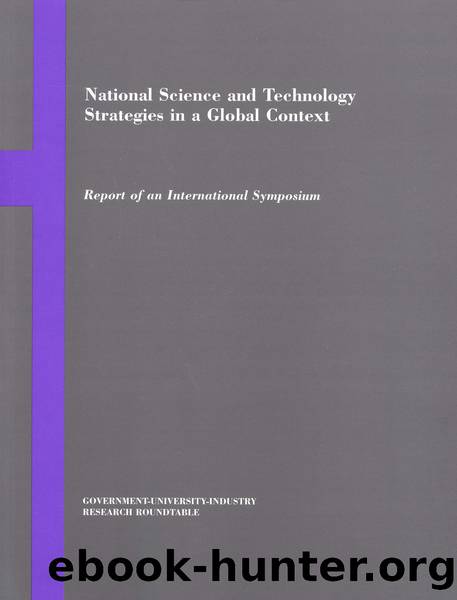National Science and Technology Strategies in a Global Context: Report of an International Symposium by National Research Council

Author:National Research Council
Language: eng
Format: epub
Tags: Policy for Science and Technology
Publisher: NATIONAL ACADEMY PRESS
Published: 1998-05-21T00:00:00+00:00
Michel Cuénod, Human Frontier Science Program (HFSP), France
HFSP is focused on promoting inter-continental cooperation in basic research in biology and neuroscience. By focusing on support for younger scientists through research grants, fellowships, and workshops, it furthers the internationalization of interdisciplinary research of very high quality. The concept was first proposed at the 1987 G-7 summit by Prime Minister Nakasone of Japan, and the program was launched in 1989 with a secretariat established in Strasbourg. In order to ensure a timely start, Japan agreed to provide the bulk of the support for the program in the initial years, with the remaining support provided by the other management supporting partners (Canada, France, Germany, Italy, Switzerland, United Kingdom, United States, and the European Union).
Basic support is provided in two fields, brain function and biological function at the molecular level. These are fields that require strong support for basic research. The problems are of high complexity. International cooperation appears to make tactical sense. Even the largest countries should profit.
A recent review by an independent panel found that the quality of HFSP awardees and proposed research were of uniformly high quality, and addressed important questions. The quality is ensured by a peer review process modeled on the study section system of NIH, with the review panels made up of two member scientists from each participating country. From the point of view of the scientific community, the absence of political bias and the focus on high quality rather than targeted subjects are particularly attractive features of the program.
Figure 3-2
Continental distribution of 232 research grant awards and of research teams during 1990â1995.
Download
This site does not store any files on its server. We only index and link to content provided by other sites. Please contact the content providers to delete copyright contents if any and email us, we'll remove relevant links or contents immediately.
The Art of Coaching Workbook by Elena Aguilar(50962)
Trainspotting by Irvine Welsh(21517)
Twilight of the Idols With the Antichrist and Ecce Homo by Friedrich Nietzsche(18501)
Fangirl by Rainbow Rowell(9093)
Periodization Training for Sports by Tudor Bompa(8168)
Change Your Questions, Change Your Life by Marilee Adams(7633)
This Is How You Lose Her by Junot Diaz(6778)
Asking the Right Questions: A Guide to Critical Thinking by M. Neil Browne & Stuart M. Keeley(5629)
Grit by Angela Duckworth(5512)
Red Sparrow by Jason Matthews(5390)
Paper Towns by Green John(5086)
Room 212 by Kate Stewart(5035)
Ken Follett - World without end by Ken Follett(4643)
Housekeeping by Marilynne Robinson(4328)
The Sports Rules Book by Human Kinetics(4288)
Double Down (Diary of a Wimpy Kid Book 11) by Jeff Kinney(4204)
Papillon (English) by Henri Charrière(4195)
The Motorcycle Diaries by Ernesto Che Guevara(4009)
Exercise Technique Manual for Resistance Training by National Strength & Conditioning Association(3954)
